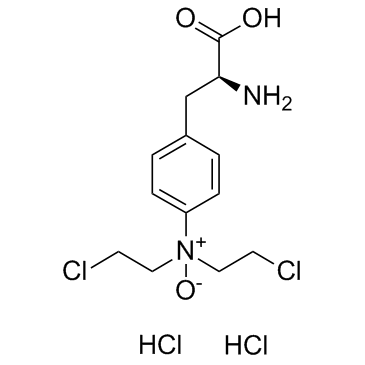685898-44-6
| Name | 4-[(2S)-2-amino-2-carboxyethyl]-N,N-bis(2-chloroethyl)benzeneamine oxide,dihydrochloride |
|---|---|
| Synonyms |
unii-t23u22x160
Phenylalanine, 4-[bis(2-chloroethyl)nitroryl]-, hydrochloride (1:2) 4-[Bis(2-chloroethyl)nitroryl]phenylalanine dihydrochloride px-478 |
| Description | PX-478 is an antitumor inhibitor of hypoxia-inducible factor-1α (HIF-1α). |
|---|---|
| Related Catalog | |
| Target |
HIF-1α[1] |
| In Vitro | PC3 and DU 145 cells express HIF-1α protein are treated with PX-478 for 20 hr under normoxia. PC3 cells are more sensitive to PX-478 as compared with DU 145 cells. Densitometric analysis shows that the IC50 for HIF-1α inhibition for PC3 cells under normoxic condition is 20-25 μM, whereas the IC50 for HIF-1α inhibition for the DU 145 cells is 40-50 μM. PC3 and DU 145 cells are treated with different concentrations of PX-478 (10, 20, 30, 40, 50, and 60 μM) for 18-20 hr under normoxia or hypoxia. Under normoxia, PC3 cells are more sensitive to PX-478 than DU 145 cells. IC50 for clonogenic survival (n=3) is 17 μM for PC3 cells and 35 μM for DU 145 cells. When cells are treated with the drug under hypoxic condition for 18 hr, the IC50 is 16 μM for PC3 cells and 22 μM for DU 145 cells. Thus DU 145 cells are more sensitive to PX-478 under hypoxic condition[1]. |
| In Vivo | PX-478 is administered to mice with congenital HO (Nfatc1-Cre/caACVR1fl/fl) every other day starting from birth for 2 wk. Treated mice have significantly less ectopic bone at the ankle joints compared with mutant mice treated with vehicle (6.8 mm3 vs. 2.2 mm3, P<0.01)[2]. |
| Cell Assay | To determine the effect of PX-478 in combination with radiation, cells are treated with PX-478 for 24 hr under normoxic condition, irradiated and plated after 1 hr. Colonies are stained with crystal violet after 12 days and the colonies of >50 cells are counted. For combination treatments, net survival is calculated by correcting the toxicity of PX-478 alone. Enhancement factor (EF) is calculated by dividing the dose of radiation required to reduce plating efficiency to 10% when cells are treated with radiation alone by the dose of radiation required to reduce plating efficiency to 10% when cells are treated with PX-478 and radiation[1]. |
| Animal Admin | Mice[2] Burn/tenotomy or hybrid HO mice are administered PX-478 (100 mg/kg) or Rapamycin (5 mg/kg) in PBS solution via intraperitoneal injection. Mice receive injections every other day for the duration of the study. Nfatc1-Cre/caACVR1fl/wt mice are administered PX-478 (100 mg/kg) every other day for a total of 2 wk. |
| References |
| Molecular Formula | C13H20Cl4N2O3 |
|---|---|
| Molecular Weight | 394.121 |
| Exact Mass | 392.022797 |
| PSA | 92.75000 |
| LogP | 4.26280 |
| Storage condition | -20℃ |
